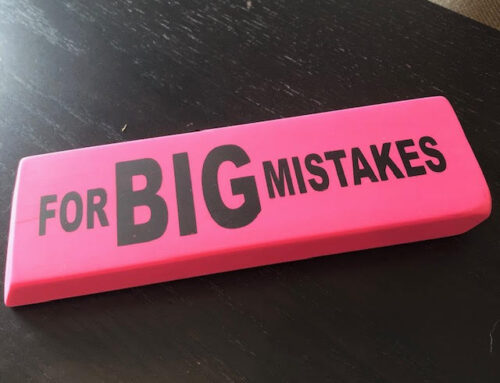Yes.
If you’re wondering whether bias exists when you give feedback, the answer is likely yes.
At its best, feedback is a gift. Sharing feedback is an investment in the other person and the fastest way to help them sharpen their skills. Feedback is a crucial component of any high-performance team and a skill worth mastering by all of us.
But, far too often, feedback is tainted by bias. While outright prejudice is easier to spot, there is a more insidious bias that often percolates below our level of consciousness. And when it comes to bias, ignorance is not an acceptable excuse. After all unconscious bias, just like deliberate discrimination, negatively affects feedback and career development.
Disparate feedback
One example of how bias shows up in feedback is when different words are often used to describe the same behaviours exhibited by men versus women, people of colour, LGBTQ+ individuals and people with disabilities. For example, where men may be described as “assertive”, women and people of colour may be described as “aggressive” or “angry”. One group is often viewed as skilled and another as lucky.
As well, women, people of colour, and other underrepresented groups often must prove themselves over and over again, determined to be “not quite ready” for promotions, whereas men tend to be promoted based on potential.
Research has also found men receive more actionable feedback than women — the kind of feedback useful for leadership progression. In this study, researchers used text analysis to identify gender-based feedback on open-ended anonymous feedback shared for 146 mid-career leaders by more than 1,000 peers and leaders. Researchers identified four differences in the feedback given to female and male leaders. Men were encouraged to be visionary, to leverage politics, to be assertive and to develop confidence in specific skills. In contrast, women were encouraged to execute others’ visions, “cope” with office politics, be cooperative (and even deferential) and develop confidence overall.
Recognizing bias
The reality is we are all biased. And bias influences our behaviours more than we may think. Best-selling author, Daniel Kahneman, who won the 2002 Nobel prize in economic science, highlights how much bias permeates our decisions in his best-seller: Thinking Fast and Slow. Similarly, authors Lori Nishiura Mackenzie, JoAnne Wehner, and Shelley J. Correll highlight the bias underpinning the typical performance review process in this article: Why Most Performance Evaluations Are Biased, and How to Fix Them.
I admit I assumed residence under the cloak of ignorant privilege for far longer than I’m proud of. But I am committed to doing better personally and professionally. I invite you to join me on these three steps to help all of us notice and interrupt unconscious bias.
Step 1: Learn
As much as our intent may be otherwise, learning about bias and recognizing our own tendency to operate in a biased way is the first step to interrupting bias. The more we learn, the more we uncover implicit bias and identify steps to move forward.
A good starting place is to understand that there are several forms of bias, including racial, affinity, attribution and gender bias, ageism and confirmation bias, as well as the halo and horns effect.
It’s also essential to understand how bias inserts itself into feedback conversations, as mentioned by many of the research findings cited in this article.
As well, it’s helpful to understand bias in general. Learn from experts such as Michelle Silverthorn, a corporate culture change expert whose website includes resources for interrupting bias, as well as access to her powerful TEDxTalk, “We are not a melting pot.” Or Tania Desa, CEO and Founder of Desa Global Leadership, whose mission it is to create voice and visibility for diverse professionals. Read articles such as this NPR article on microaggressions, as well as books like: Blindspot: Hidden Biases of Good People by Mahzarin R. Banaji and Anthony G. Greenwald, White Fragility: Why It’s So Hard For White People to Talk About Racism by Robin DiAngelo, Diversify, by June Sarpong, and The Purpose of Power: How we come together when we fall apart, by Black Lives Matter co-founder Alicia Garza.
As Anthea Kelsick says, “It’s ok to not have all the answers…It is not ok for us to avoid seeking answers, or to avoid challenging ourselves and each other.” Kelsick is the Co-CEO of Certified B Corporation, an organization committed to achieving a global culture shift to redefine success in business and building a more inclusive and sustainable economy.
Step 2: Discuss
Courageous discussions help us shine a spotlight on bias in feedback and career development.
On that note, how can you create a safe place to discuss bias? Can you invite people to share their perspective during one-on-one meetings? Can you provide a confidential forum for people to draw attention to biased feedback? Can you discuss your commitment to overcome biased feedback shared during team meetings?
If you’re struggling to discuss bias, here are some conversation starters:
Where do you notice bias exists on our feedback process? What do you recommend we do to address it and hold each other accountable?
What additional steps do you recommend we take to ensure our team is fairly and consistently evaluated?
How can we ensure all of our team members have equal access to mentoring and career development opportunities?
What do you recommend I do, as a leader, to enable career development that is free from bias?
It can be intimidating speaking about bias. But clearly, avoiding this conversation isn’t the right approach. The more we all commit to having potentially uncomfortable conversations, the more effective our actions become.
As American political strategist, Symone D. Sanders wisely said, “There’s no system in power anywhere in this world that is begging for someone to come change it. Change comes about because people that believe in something better come together and put pressure on the system, so the system can do nothing but act.”
Step 3: Take action
The third and most crucial step is to take action to mitigate, and ideally, eliminate bias of all kinds. This step is not something we can excuse ourselves from. We all need to be a part of the solution. As demonstrated by Founding Director of Boston University’s Center for Antiracist Research and one of Time’s Most Influential People of 2020, Ibram X. Kendi, it’s not enough to simply be aware; we also have to act to avoid being complicit. “Being an antiracist requires persistent self-awareness, constant self-criticism, and regular self-examination.”
This doesn’t mean we need to be experts before we take action. We can follow the lead of our underrepresented groups and lean on our Diversity & Inclusion experts, both within and outside our organization. Often, the best action we can take is to support their efforts.
One immediate step you can follow is to embrace “wise criticism”. Sharing critical feedback with an underrepresented individual can be tricky. If you’re too critical, it may come across as biased. But if you avoid sharing developmental feedback, it can be condescending and patronizing. This dilemma creates attributional ambiguity (i.e., being unclear why you are or are not receiving feedback) and can hinder both development and trust.
You can overcome this disambiguation by adopting “wise criticism” (also called “high standards”) for constructive feedback. Research led by Stanford University Associate Professor Geoffrey Cohen found developmental feedback had a more positive impact when framed in your belief in one’s capabilities. In a series of studies, there was a stark difference between Black students who heard “I’m giving you these comments, so you have feedback on your essay” versus “I’m giving you these comments because I have high standards and I know you can meet them.” Only 17% in the former group chose to revise and resubmit their work. But 71% in the latter group revised and resubmitted their work, on par with the positive response exhibited by white students. “Wise criticism” makes it clear the feedback is about standards, expectations and belief in the other person’s abilities.
In addition to “wise criticism”, there is a wide range of action we can take, including:
- Commonality: Find points of similarity with each of your colleagues. The more we perceive differences, the more likely we are to succumb to unconscious bias. We can offset this by leaning into common interests, goals, and experiences.
- Blatant bias: Interrupt bias when you witness it. For example, if you notice one person sharing biased feedback to another during a meeting, call it out. A clear, “that is not an opinion we support”, sends a strong message. Or present a thought-provoking question such as “Can you please help me understand why you are asking this question?” And while I recommend sharing constructive feedback in private, when it comes to bias, the needs of the group outweigh the individual, so I advocate speaking up in the moment.
- Equal opportunities: Rotate high-profile, developmental opportunities among all team members. At the same time, equally distribute time-intensive logistical and supporting tasks across your team as needed. Commit to equally encouraging women to focus on visionary goals and men to focus on operational tasks.
- Equal voices: Proactively invite equal voices during meetings and circle back to people who are cut off. On a similar note, ensure ideas are attributed to the correct originators.
- Encourage all employees to develop their network of champions and stakeholders so they can leverage the clear benefits of sponsorship.
- If you believe a team member needs to be more confident, provide them with actionable advice focused on specific skills. Avoid blanket “be more confident” advice.
- Learn about each of your team members’ leadership aspirations. Encourage them to be vocal about their goals and support them with developmental opportunities.
- Monitor whether biased language is used during performance reviews. For example, are you referring to a man as assertive, but a woman as aggressive?
- Objectively consider whether an individual truly has demonstrated the desired skill before declaring them “not quite ready”. Ensure all promotion recommendations are equally driven by proven performance (versus potential).
- Consider whether you are subjectively giving people who share your gender, race or alma mater an advantage. (Affinity bias)
- Document feedback throughout the year to avoid relying too heavily on what you remember. Otherwise, the halo and horns effect can unfairly penalize underrepresented individuals.
- Collect feedback from a wide range of people, in addition to the employee’s direct leader.
- Focus on objective evaluations with easily verifiable results. Too many feedback conversations and formal performance reviews rely on a large subjective component, leaving room (too much room) for a reviewer’s biases.
- Consider a leader’s track record for developing and promoting diverse individuals. What do the results tell you?
- If you’re wondering whether your feedback is biased, consider whether you would give this feedback to someone similar to you. If the answer is no, you may be drawing on biased stereotypes.
Of course, the above approach applies to all of our interactions, at work and in life, far beyond giving feedback. This approach applies to our team meetings, project assignments, casual conversations, hiring decisions, and more.
The more we recognize, learn about and discuss bias, the more we can support our experts and take the necessary steps to disrupt and eliminate bias.
Feedback is indeed a gift. And as leaders, sharing feedback is also our obligation – an obligation that includes eradicating bias underlying all interactions.
I acknowledge I am not an expert on bias. But together with my team, we are committed to learning and to integrating equality and inclusion discussions into our work to broaden our own awareness and action, and to do the same for those we train, so we use feedback to empower, uplift and unify our workplace.
I welcome your feedback on this article, and I encourage you to please share any other useful resources we should all be aware of so we can continue this conversation.
Thank you.







Leave A Comment